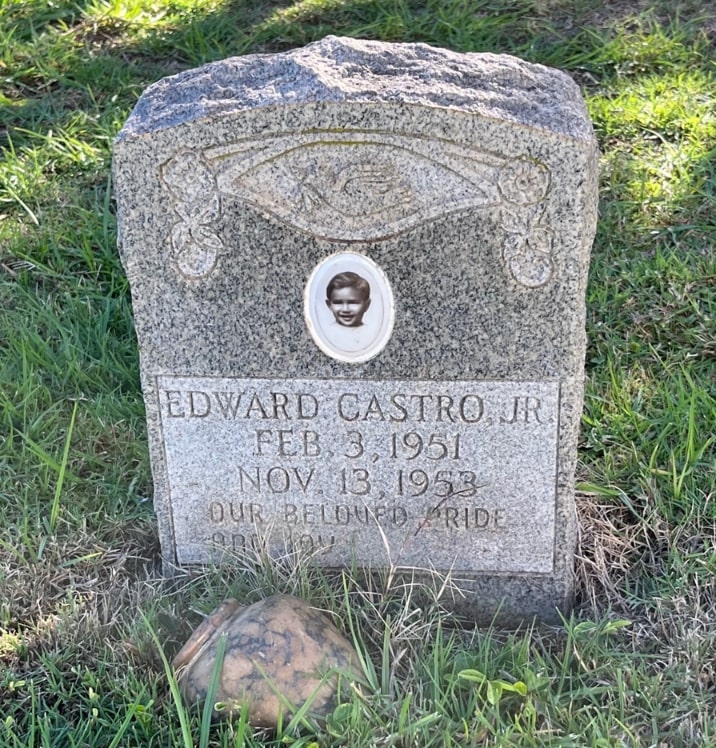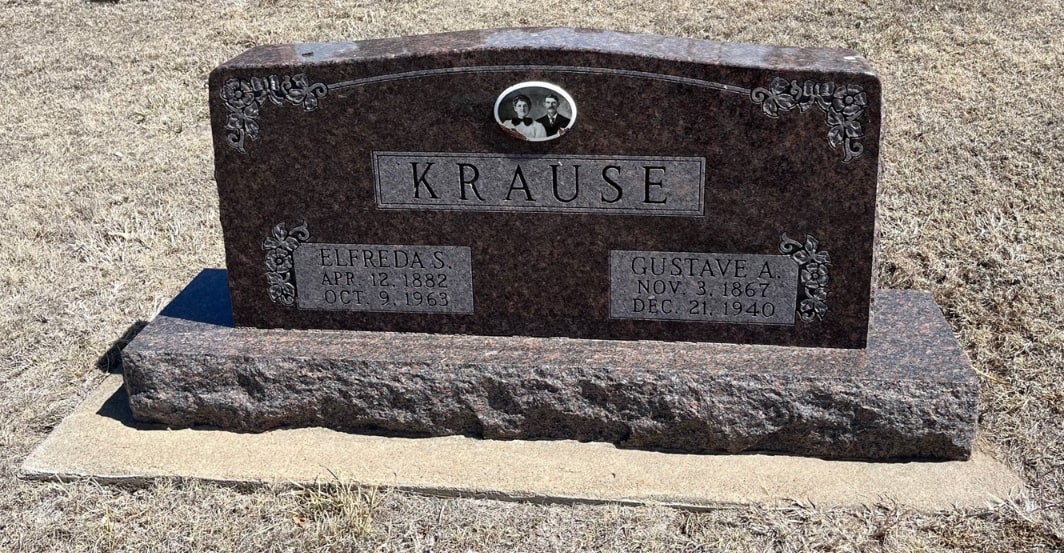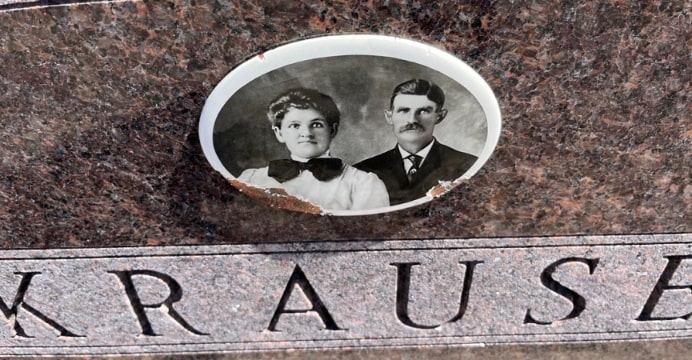Introduction: In this article, Gena Philibert-Ortega writes about a feature you occasionally see on gravestones: a porcelain portrait of the deceased. Gena is a genealogist and author of the book “From the Family Kitchen.”
Perhaps you’ve seen them as you visited a cemetery. The ultimate in identification from the beyond, porcelain photos adhered to gravestones give the cemetery visitor a glimpse of what the deceased looked like while here on earth. They personalize a final resting place in a way that inscribed words and dates can’t. How did this burial marker addition evolve? When might you expect to see a portrait affixed to a gravestone?

The Advent of Porcelain Portraits
The daguerreotype process was invented by Louis Daguerre in 1839. Over time other and better techniques for printing photographs evolved, such as the ambrotype in 1854 and, two years later, the tintype. (1)
The photographic technique that eventually had an impact on gravestone personification is photoceramics, first patented in 1854 by two French photographers. The method they developed allowed an image to be transferred to porcelain or enamel, and that was then fired in a kiln. (2) While not specifically invented for use on burial markers, in the latter 19th century the portraits were used to adorn gravestones in Europe. (3)

In the United States, we start to see newspaper advertisements for porcelain portraits by the 1870s. This example, from Judd’s Gallery in Connecticut, advertises that they have “Photographs of every style” including “Porcelain Portraits.” Families could purchase porcelain portraits as an alternative to paper photographs for display in their homes.
In 1893 an American businessman, Joseph Albert Dedouch, received a patent and began manufacturing porcelain portraits in Chicago. The portraits evolved to include color and edited images. (4) As you study various cemeteries you can see when the addition of these porcelain portraits was popular in a particular area and with whom.
For example, though the ability to add porcelain portraits to grave markers predates the 1920s, this Coldwater, Michigan, newspaper mention seems to indicate that it was new to local cemeteries. The author writes that the portrait set into a granite marker was “new in the line of grave markers.”
Bereaved families did not have to rely solely on local monument makers or photographers to provide a porcelain portrait for a marker. Twentieth century monument catalogs from retailers like Sears and Montgomery Ward offered this service.
This 1919 Sears Catalog said that photographs had been attached to tombstones in the past in many ways, including paper photographs behind glass attached with putty (which can be destroyed by water and sunlight). (5) The longer-lasting porcelain was said to not be affected by the weather or elements. The process for acquiring a porcelain portrait for a gravestone from Sears started with the customer providing a paper photograph that Sears would then transform into a porcelain portrait.
Interestingly enough, though they admit they cannot improve upon a photograph, they are able to make “minor changes” including straightening neckties or removing other people in the photo. The finished product could then be adhered to the monument with cement. Customers could buy the portrait itself or pay for it to be set in a marble or granite gravestone they purchased from the retailer.
My favorite part of this page is the tiny copy on the right that states they had a fire in their marble shop and the porcelain portraits were not damaged even though the marble monuments had been nearly destroyed. That’s a testimonial!
This testimonial read:
“After a bad fire at our marble shops we found three Porcelain Portraits where the heat had been most intense. They were not injured in the least, although the marble monuments in which they had been set had crumbled and fallen to pieces.”
These porcelain portraits were meant to last indefinitely. Even so, some people took extra precautions to protect the portraits. Today, as you stroll through a cemetery you may find these porcelain portraits hidden by a similarly shaped metal door that can be gently moved to the side, revealing the portrait. They may also be found behind glass or simply adhered to the stone.
Unfortunately, cemeteries have always been the target of vandals. Portraits are not safe from those who are bent on destruction. It’s not unusual to see that a portrait has been pried off the stone, smashed, or scratched. This 1969 letter to the editor from Mrs. George Gero Jr. recounted that her young son’s porcelain portrait had been pried off his burial marker and taken. The 8-year-old was killed on his bicycle by a truck.
Families can still purchase porcelain portraits as a keepsake or to adhere to a memorial. They are available online. The benefit of having the person’s photo on the marker is that it personalizes it beyond what a name, birth date and death date can do.
A Portrait of a Life Lived
I love cemeteries because they are an outdoor art museum. They reveal the stories of those who reside there via their markers, verse, and photographs of the dearly departed. Families who paid for a porcelain portrait have left us an additional clue about the life memorialized on that very spot.
Explore over 330 years of newspapers and historical records in GenealogyBank. Discover your family story! Start a 7-Day Free Trial
Note on the header image: Mr. and Mrs. Krause porcelain portraits on their gravestone, WaKeeney City Cemetery, Trego County, Kansas. Credit: Gena Philibert-Ortega.
Related Articles:
- It’s Not All Online: Cemetery Research
- Genealogy Tips: Lessons Learned from Writing a Cemetery Book
- Genealogy Tip: What Does a Gravestone Tell Us?
- Genealogy Tip: What a Gravestone Tells Us – Grave Markers
- Genealogy Tip: How Accurate Is That Gravestone?
- Cemetery Language: A Glossary for Genealogists
- Genealogy Tip: White Bronze Markers at Cemeteries
_____________________
(1) “Identifying Photograph Types,” PhotoTree (http://phototree.com/identify.htm: accessed 13 May 2023).
(2) “What are Photoceramic Portraits?,” Coyle Studios (https://restoreoldphotosnow.com/what-are-photoceramic-portraits/: accessed 13 May 2023).
(3) Ibid.
(4) “Faces in Porcelain: Photo-Ceramic Memorial Portraits in New Orleans,” Oak and Laurel Cemetery Preservation (http://www.oakandlaurel.com/blog/faces-in-porcelain-photo-ceramic-memorial-portraits-in-new-orleans: accessed 13 May 2023).
(5) Available from Internet Archive at https://archive.org/details/monumentstombsto00sear/page/42/mode/2up
